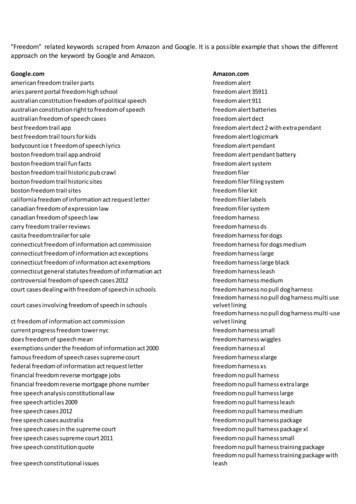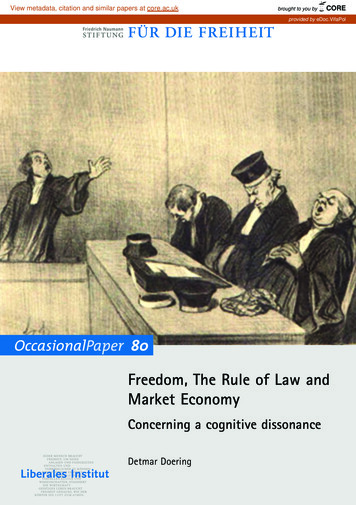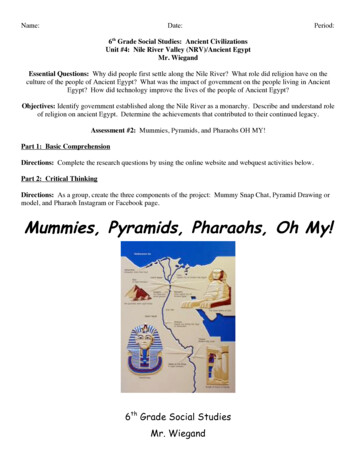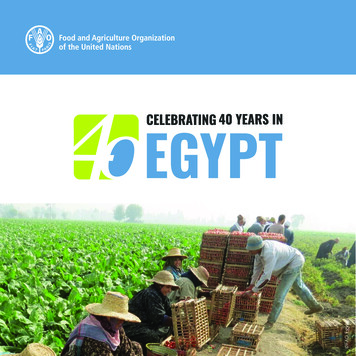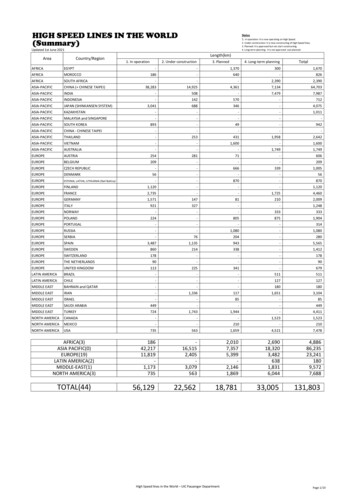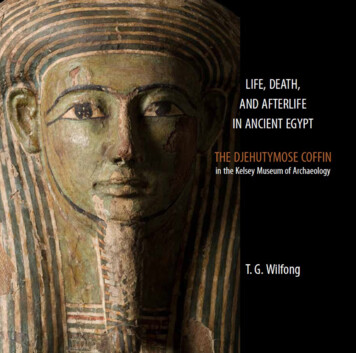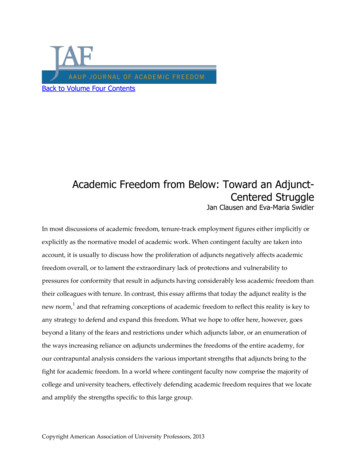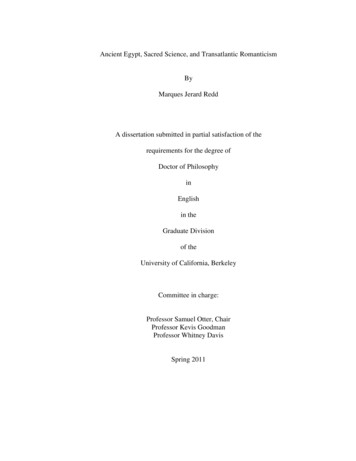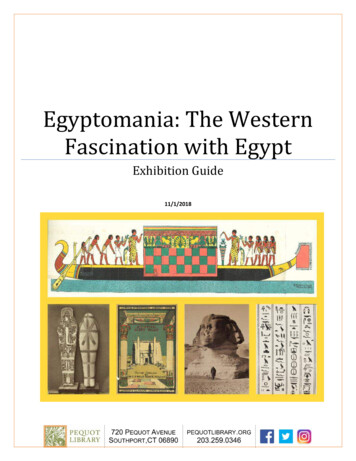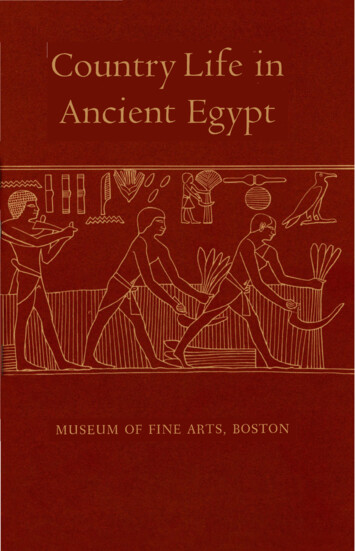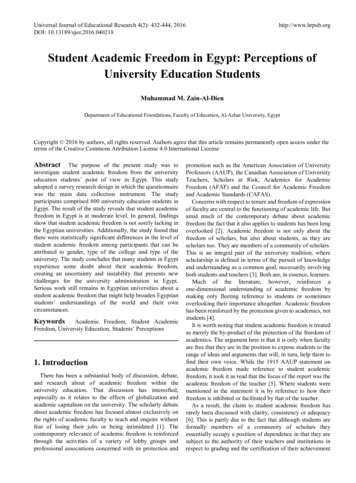
Transcription
Universal Journal of Educational Research 4(2): 432-444, 2016DOI: nt Academic Freedom in Egypt: Perceptions ofUniversity Education StudentsMuhammad M. Zain-Al-DienDepartment of Educational Foundations, Faculty of Education, Al-Azhar University, EgyptCopyright 2016 by authors, all rights reserved. Authors agree that this article remains permanently open access under theterms of the Creative Commons Attribution License 4.0 International LicenseAbstract The purpose of the present study was toinvestigate student academic freedom from the universityeducation students’ point of view in Egypt. This studyadopted a survey research design in which the questionnairewas the main data collection instrument. The studyparticipants comprised 800 university education students inEgypt. The result of the study reveals that student academicfreedom in Egypt is at moderate level. In general, findingsshow that student academic freedom is not sorely lacking inthe Egyptian universities. Additionally, the study found thatthere were statistically significant differences in the level ofstudent academic freedom among participants that can beattributed to gender, type of the college and type of theuniversity. The study concludes that many students in Egyptexperience some doubt about their academic freedom,creating an uncertainty and instability that presents newchallenges for the university administration in Egypt.Serious work still remains in Egyptian universities about astudent academic freedom that might help broaden Egyptianstudents’ understandings of the world and their owncircumstances.Keywords Academic Freedom, Student AcademicFreedom, University Education, Students’ Perceptions1. IntroductionThere has been a substantial body of discussion, debate,and research about of academic freedom within theuniversity education. That discussion has intensified,especially as it relates to the effects of globalization andacademic capitalism on the university. The scholarly debateabout academic freedom has focused almost exclusively onthe rights of academic faculty to teach and enquire withoutfear of losing their jobs or being intimidated [1]. Thecontemporary relevance of academic freedom is reinforcedthrough the activities of a variety of lobby groups andprofessional associations concerned with its protection andpromotion such as the American Association of UniversityProfessors (AAUP), the Canadian Association of UniversityTeachers, Scholars at Risk, Academics for AcademicFreedom (AFAF) and the Council for Academic Freedomand Academic Standards (CAFAS).Concerns with respect to tenure and freedom of expressionof faculty are central to the functioning of academic life. Butamid much of the contemporary debate about academicfreedom the fact that it also applies to students has been longoverlooked [2]. Academic freedom is not only about thefreedom of scholars, but also about students, as they arescholars too. They are members of a community of scholars.This is an integral part of the university tradition, wherescholarship is defined in terms of the pursuit of knowledgeand understanding as a common goal, necessarily involvingboth students and teachers [3]. Both are, in essence, learners.Much of the literature, however, reinforces aone-dimensional understanding of academic freedom bymaking only fleeting reference to students or sometimesoverlooking their importance altogether. Academic freedomhas been reinforced by the protection given to academics, notstudents [4].It is worth noting that student academic freedom is treatedas merely the by-product of the protection of the freedom ofacademics. The argument here is that it is only when facultyare free that they are in the position to expose students to therange of ideas and arguments that will, in turn, help them tofind their own voice. While the 1915 AAUP statement onacademic freedom made reference to student academicfreedom, it took it as read that the focus of the report was theacademic freedom of the teacher [5]. Where students werementioned in the statement it is by reference to how theirfreedom is inhibited or facilitated by that of the teacher.As a result, the claim to student academic freedom hasrarely been discussed with clarity, consistency or adequacy[6]. This is partly due to the fact that although students areformally members of a community of scholars theyessentially occupy a position of dependence in that they aresubject to the authority of their teachers and institutions inrespect to grading and the certification of their achievement
Universal Journal of Educational Research 4(2): 432-444, 2016through the award of degrees. Although rarely stated in acontemporary context, an implicit, but patronizing,assumption is that, as novices or scholars in training,students do not possess the knowledge necessary to makesufficiently informed judgements [7].2. Review of LiteratureIn general, this article seeks to elaborate the claim tostudent academic freedom more broadly. It has specificallyinvestigated student academic freedom in Egyptianuniversity education. Therefore, four categories of literaturewere reviewed: student academic freedom - its definition anddomains; developing student academic freedom in terms ofrights; the politicization debate and student academicfreedom in Egypt.2.1. Student Academic Freedom: Definition and DomainsProviding a fixed definition of academic freedom isdifficult because no single definition can cover all thecomplexities associated with the concept or adequatelyaccount for the many cultural contexts where it is practiced.Some scholars tend to define a student academic freedom asstudent’s right to exercise freedom of expression and toparticipate in social and political activities [8, 9]. On theother hand, other scholars tend to define it as a student’s rightto express his/her ideas and opinions, to choose the studyfield and to participate in decision making [10].Most Western scholars would agree that these conditionsare essential to provide students with the climate they need tolearn. Hence, university students are citizens and members ofa learned profession. When they speak or write as citizens,they should be free. They should be responsible, accurateand should respect the opinion of others [11].Concerning Egyptian universities, the concept of studentacademic freedom is recognized by internationalorganizations like UNESCO as a guarantor of otherfundamental human rights, such as freedom of speech,freedom in carrying out research and disseminating andpublishing the results thereof, freedom to express freely theiropinion about the society or system in which they learn,freedom in selecting study field, and freedom indecision-making. All members of learning process in highereducation learning should have the right to fulfill theirfunctions without discrimination of any kind and withoutfear of repression by the state or any other source [12].For the purpose of this paper, the author has developeddimensions of a student academic freedom that draws uponvarious documents. These dimensions include four basicelements that must be considered. First, students are entitledto full freedom in expressing their opinions and ideas [13-15].The second element is the freedom of students in selecting astudy field and content of subjects [16-18]. The third elementis the right of students to participate in decision making[19-22]. The last element is that students are entitled to full433freedom in research and in the publication of the results[23-26].2.2. Developing Student Academic Freedom in Terms ofRightsDeveloping student academic freedom in terms of rights isimportant since it implies a proactive stance. This can bedone through seeking to develop the independence ofstudents as thinkers and learners to their fullest extent.Assuming they support academic freedom, this means thatuniversities, and their faculty, have an obligation to promotestudent capability. This, ultimately, is the most effectivemeans of ensuring student academic freedom is protected.Student capability depends on education and thispresupposes the right to gain access to a university education.This implies campaigning for access to higher education asan affordable right for all, regardless of formal and informalhistorical restrictions such as religion and social class.Article 26 of the 1948 Universal Declaration of HumanRights states that everyone has the right to an education andthat higher education should be accessible on the basis ofmerit. Participation rates in higher education have risenrapidly in a large number of developed and developingeconomies since the late twentieth century. Globally theproportion of young people going on to tertiary educationhas risen from under one in five in 2000 to more than one infour in 2007 with women now outnumbering men [27].However, there are though stark regional differences withjust 6% of Africans entering tertiary education comparedwith more than 70% in North America and Europe [28].Even in developed country contexts barriers to access tohigher education represent a threat to students gaining theopportunity to develop their full capabilities. Hence, it isimportant to recognize that mass access to higher educationis a comparatively recent phenomenon. Critically, access to ahigher education is now being viewed as a right rather than aprivilege.Moreover, student academic freedom depends on auniversity curriculum that enhances the capability ofstudents to develop as independent and critical thinkers. Ithas long been argued that students have a right to a general orliberal education in the shape of a university curriculumwhich is sufficiently broad to enable someone to become anindependent and critical thinker as well as, perhaps, play aninformed role as a citizen. The case for the contemporaryrelevance of a liberal undergraduate curriculum has beenrecently made. MacIntyre [29] argues that undergraduateeducation needs to be seen as something that has its ownends which are distinctive from, and not simply a prologuefor, graduate or professional education.Another argument is that the pace of change in the modernworld makes specific skill and knowledge sets rapidlyoutmoded. Only a broad, liberal education, that developshuman qualities and dispositions rather than ‘generic skills’,can adequately prepare students for an essentially unknownfuture [30]. In other words, a broad curriculum is more likely
434Student Academic Freedom in Egypt: Perceptions of University Education Studentsto ‘future-proof’ graduates. Conscientious faculty invocational areas of the curriculum have long understood theimportance of a curriculum which seeks to strike a balancebetween teaching time-sensitive employment-related skillsand a broader theoretical and contextual knowledge basewhich is future oriented. Those who teach visualcommunication courses, for example, are conscious of therisks of focusing too heavily on software skills. The rapidpace of change in their industry means that what is currentnow may soon be redundant [31].Thinking of the curriculum in this way would imply theprovision of sufficient opportunities for students to addbreadth to their specialist studies via elective courses. Thisdoes not mean that conventional course-based degreesdevoid of electives cannot produce breadth of learning butthat general education via electives can add a furtherdimension to the development of students. In its originalsense, Lernfreiheit implied that students should be free toroam between institutions of higher education, pursuewhichever courses took their fancy, and attend as theywished and not to be subjected to any form of test except fora final examination [32].Modern higher education is very far from this idealizedportrait of the student as an unencumbered travelling scholar.Many courses in higher education are highly specialized andoffer students tightly restricted opportunities to take electivesoutside a relatively narrowly defined curriculum. Moderncourses have been packaged into ‘modules’ or ‘units’ whichallow few opportunities for students to develop their criticalthinking or evaluative skills.While AACU’s statement about academic freedomfocuses on the politicization issue [33], there is recognitionof the importance of a liberal education in helping students todevelop the skills of critical thinking and enquiry whichenable them to develop their own perspectives on issues thatface modern society. Hence, there is an implicitunderstanding here that liberal education is a key positiveright that facilitates student academic freedom. The moderncurriculum of higher education though is tending to restrictthe extent to which students are able to develop abroadly-based understanding of knowledge which wouldmake them more informed as citizens and, hence, able toexercise their rights as fully as they might do.set of ‘liberal’ values [35].It is claimed by Horowitz’s campaigning organization,Students for Academic Freedom, that there is a lack of‘balance’ in the teaching of controversial subjects and thiscreates a classroom atmosphere which is intolerant tostudents with dissenting views. The effect of this process,according to Horowitz, is that students are prevented fromdeveloping their own independent thinking or might, to someextent, self-censor. The Student Bill of Rights, produced byHorowitz, focuses exclusively on concerns with respect to‘indoctrination’ of students as a violation of their freedomsand the potential impact of related issues, such as unfairassessment, which might affect a student who expressesopinions contrary to those held by their professor [36].Despite the concerns raised by Horowitz, the 1915statement on academic freedom issued by the AAUP doesinclude a clear instruction that students in their formativeyears of undergraduate education should be safeguardedfrom unbalanced approaches [37]. Horowitz’ campaignthough has led to the AAUP issuing a response entitledFreedom in the Classroom. AAUPs 2007 statement affirmsthat it is a teachers’ right to test out their opinion and beliefson controversial issues in the classroom without regard to theextent to which the views expressed represent opinions basedon untested assertions [38].Here, a counter-argument is that faculty should distinguishbetween audiences. Students (especially undergraduates)should be distinguished from professional or disciplinarypeers. In other words, the testing out of controversial or newideas should be directed at peers, and in the context of ascholastic debate, with equals. In an earlier incarnation of thecontroversy about the politicization of the curriculum,Weber [39] distinguished between opportunities to professviews in the classroom and to peers and talked of the‘obligations of self-restraint’ on the university teacher.Moreover, the Association of American Colleges andUniversities (AACU) have issued a defensive statementabout student academic freedom in response to Horowitz’scampaign [40]. In common with that issued by the AAUP, itfocuses on discussing student academic freedom almostexclusively in terms of the politicization debate.2.4. Student Academic Freedom in Egypt2.3. The Politicization DebateThe debate of student academic freedom has normallycentered on the so-called politicization of the curriculum.The assumption here is that being ‘‘free to learn’’ meansbeing free from indoctrination [34]. In the United States, thedebate about student academic freedom has focused almostexclusively on the contention of neo-conservative lobbyistsand critics that students are being politicized by radicaluniversity teachers. This cause is championed by DavidHorowitz and his Students for Academic Freedom campaign,which argues that a left leaning professoriate is trying toradicalize university students by indoctrinating them with aIn Egypt, Huff [41] points out, two frames must be used toexamine student academic freedom. The first is the politicalframework and factors that emerge from authoritarian stateofficials. The second is the religious and cultural frameworkthat is built upon religious traditions. The key issue here isthat these frameworks are strongly integrated and reinforceeach other, and this relationship plays a significant role inshaping the understandings of political, cultural, andeducational issues such as academic freedom.Student academic freedom in Egyptian context facespressures similar to those in any country that remains underauthoritarian rule. Kraince [42] states that the major obstacle
Universal Journal of Educational Research 4(2): 432-444, 2016to building respect for academic freedom in Arab societies isthe persistence of authoritarian culture. For example, someauthoritarian regimes build restrictions into academic work,hampering and discouraging student academic freedom [43].This is evident in Egypt and all Arab universities whenheavy-handed and security-oriented administrations ofteninterfere in student academic life in areas such as studentadmissions, student research, student conduct and choice ofcurricular materials. Certainly, the degree of authoritariangovernment control greatly varies among Arab countries.However, the key problem is that this type of top downcontrol of discourse limits the free-flowing marketplace ofideas, where viewpoints are distinguished on the basis oftheir substance, persuasive power and/or utility [44].The second framework that shapes student academicfreedom is related to religion and traditions, with whichEgyptian education has long been intertwined. Thus, religionplays a significant role in constructing the parameters ofstudent academic freedom. Taha-Thomure [45] states thatconstants in Egyptian and Arab society, that is the basicfoundational ideas of religion, society and tradition, areinfluential in engineering the width and breadth and depth offreedoms permitted. In societies where general freedom isnot allowed, we usually find that traditions and beliefs take apreeminent role in defining what kinds of knowledge are orare not accepted. Societal beliefs and traditions can evenaffect the special freedom that might be allowed inuniversities.These traditions and beliefs play a huge role in shapingacademia. It is clear that the role of the student in Egyptianuniversity is substantially different from that of one in awestern university because the religious life andinterpretations take preeminence over secular, academicstudies [46].The common element within these frameworks that shapeacademics in Egypt as well as the Arab world is the issue ofpower. In this context, knowledge has a utilitarian functionof providing legitimacy for the political and religiousestablishments; thus it is no longer a tool to initiate changebut rather an instrument that supports and comforts theestablished political order [47].Those who hold power andsee oppositional knowledge as a threat to their legitimacy areunlikely to tolerate discourse that questions the purpose oftheir existence, raises questions regarding government, orchallenges the privileged knowledge of overarchingnarratives. One can easily infer how those who hold powerset the boundaries on student academic freedom and, in turn,on the knowledge transmitted in academia [48].University students in the scientific disciplines can learnand conduct research with minimal restrictions but those infields such as the social sciences and humanities encountermore restrictions on their learning, expressing and writing.University students in disciplines that are fertile forcontroversy attempt to provide ‘‘objective’’ historicalaccounts and ‘‘soft analyses’’ of critical issues. Thosestudents, who think, discuss and express new ideas that435challenge the status quo and power structures in authoritariancultures are particularly vulnerable to any lack of freedom ofspeech in a society, because existing entrenched interestswill resist the challenge posed by new ideas [49].The Present StudyThe scholarly debate about academic freedom, inside andoutside Arab republic of Egypt has focused heavily on therights of academic faculty [50-58]. Student academicfreedom is rarely discussed and is normally confined todebates [59-62]. The present study, which takes place acrossuniversity students in Egypt, helps to address this gap in theresearch by addressing all aspects of student academicfreedom from the literature and exploring these in moredetail with data collected in Egyptian universities. The fourkey aspects of the student academic freedom that have beenidentified for inclusion in the present study are freedom ofexpression, freedom in decision-making, freedom inselecting study field and freedom in conducting research.Therefore, it is important to determine the level of studentacademic freedom in all aspects in Egyptian universities. Toachieve the study objective, the following research questionswere developed:(1) To what extent do the university education studentsexercise academic freedom?(2) Are there any statistically significant differences inthe level of student academic freedom amongparticipants that can be attributed to gender?(3) Are there any statistically significant differences inthe level of student academic freedom amongparticipants that can be attributed to type of thecollege?(4) Are there any statistically significant differences inthe level of student academic freedom amongparticipants that can be attributed to type of theuniversity?3. Methodology3.1. Research DesignThe current study was quantitative in which sample surveyresearch design was used. The researcher chose this methodbecause survey research is useful in describing thecharacteristics of a large population; very large samples arefeasible, making the results statistically significant evenwhen analyzing multiple variables.3.2. ParticipantsThe population in this study consisted of all universitystudents in Egypt during the academic year of 2014. Theparticipants of the study comprised 800 university studentsin Egypt. Table 1 shows characteristics of the participants.
436Student Academic Freedom in Egypt: Perceptions of University Education StudentsTable 1. Participant characteristicsVariableGenderType of the collegeType of theuniversityTotalLevels of 9.375800100%3.3. InstrumentationA questionnaire, developed by the researcher after anextensive review of the literature, was the main instrumentused for the collection of data for the study. It was dividedinto two major sections. Section one has requireddemographics information about the university students inEgypt. The other section included 44 close-ended items,which were divided into four domains (freedom ofexpression, freedom in decision-making, freedom inselecting study field and freedom in conducting research).These items were rated on five-point Likert-type scales(from strongly agree to strongly disagree). The questionnairewas given to a panel of 15 university professors in Egyptfrom different educational specializations includingeducational foundations, curriculum and instruction, andevaluation and measurement. The purpose of this was tocheck the clarity of items, its relevance to the domain and thescale as a whole. All comments and points of view weretaken into consideration and some items were modified,changed, or deleted after a deep discussion with each one ofthe college teachers. After putting the reviewers’ remarks,the final version consisted of 40 items distributed over thefour domains. The construct validity was measured in whicha group of 50 university students, apart from the studysample, participated in the pilot study. The correlationcoefficient was calculated among the domains. The values ofPearson correlation coefficients ranged from 0.71 to 0.82.All the coefficients were significant at (α 0.05). Moreover,reliability for the current questionnaire was assessed usingthe 50 university students in Egypt. The Cronbach's alphareliability was 0.91. The reliability in all domains and as thewhole scale was high.3.4. Data AnalysisThe researcher distributed the questionnaire to publicprimary and private university students enrolled at the highereducation in Egypt after obtaining permission from Al-AzharUniversity in Cairo. The collected data were analyzed usingdescriptive statistics, such as means and standard deviations.In addition, T-test was used to find out whether thedifferences in the mean scores of university students ingroups were statistically significant (α .05). In order tounderstand the results of the current study, it was importantto set specific cut points to interpret the participants’ totalscores. It should be noted that the researcher used theresponse scale of each item that ranged from 1 to 5 todetermine these cut points according to the following manner:(1- 2.33 low), from (2.34 - 3.67 moderate), and from(3.68 - 5.00 high level).4. Results and DiscussionData that obtained from questionnaire were presented,discussed and analyzed using SPSS software package foreducational studies in order to answer the research questions.This is done under four themes as follows:4.1. Research Question 1To answer the first research question, the means andstandard deviations were calculated for the total scores ofeach domain and were ranked according to their meanvalues.Table 2. Descriptive statistics for the university education students’ viewsDomainMSDRankFreedom in selecting study field3.700.161Freedom in decision-making3.540.312Freedom in conducting research3.380.183Freedom of expression3.040.194Total3.500.32-As shown in the Table 2, the student academic freedom inEgypt is at moderate level from the university educationstudents’ point of view (mean 3.50 and standard deviation 0.32). Though the total score of the four domains is inmoderate level, the domain of “freedom in selecting studyfield” has achieved slightly better results with mean of (3.70)and standard deviation (0.16). Therefore, the respondents’decisions show that the level of “freedom in selecting studyfield” is high. On the other hand, the domain of “freedom ofexpression” has the lowest mean of (3.04) with standarddeviation (0.19).Although it is clear that student academic freedom is notsorely lacking in the Egyptian universities as indicated in theTable 2, students are academically affected by cues abouttwo schools of thought; namely the schism the more liberallyminded Islamic rationalist school of thought that encouragedcritical thinking and active dissent, and the Islamictraditionalist school that dominated religious teaching hasleft the Arab legacy that favour revelation over reason [63].This finding is consistent with research showing that thelevel of student academic freedom at university context inKuwait was (3.18); which is at a moderate level [64]. On theother hand, this finding ontradicts other research showingthat the students’ ability to speak freely in academia remainsat risk and there are many restrictions on student academicfreedom that persist across the Arab region [65, 66]. Table 3reveals the means and standard deviation for the domainitems of “freedom in selecting study field”.
Universal Journal of Educational Research 4(2): 432-444, 2016437Table 3. Descriptive statistics for the domain items of “freedom in selecting study field”.No.ItemMSDRank11The university students select their specialization according to their desires and abilities.4.900.3015The university provides support and guidance to students about the necessary knowledge to specialize.4.820.5322The university students participate in the presentation of the teaching material within the lecture.4.310.46316The university students are provided with methods that enable them to acquire knowledge.4.110.35431The university students are involved in determining the extra-curricular activities of courses.4.030.43526The faculty teacher gives students the opportunity to discuss aspects of the curriculum they learn.3.920.36621The faculty teacher engages students when choosing the course topics.3.780.80736The university provides sufficient opportunities for students to choose courses.The university students’ suggestions are taken into consideration when determining the dates of theexaminations.The university students can move from one major to another according to certain 4TotalTable 4. Descriptive statistics for the domain items of “freedom in decision-making”.No.ItemMSDRank6The university allows students to join NGOs.4.670.63120The university provides opportunities for students to participate in various seminars.4.620.66210The university students are involved in the management of various activities.4.620.68315The university allows students to set many committees that managed by them.4.520.66430The university encourages students to participate in overseas conferences.4.010.44525The university provides students adequate opportunities for making some of their own college decisions.3.290.68671The university takes students suggestions into consideration in solving their own problems.3.260.6935The university students are involved in the process of courses description.3.240.6289The university students’ views regarding developing educational process are appreciated.1.950.48934The university gives opportunities to set students’ unions.1.220.47103.540.31-TotalIn Table 3, the respondents’ decisions show that thedomain of “freedom in selecting study field” is high. It hasthe highest mean of (3.70) with standard deviation (0.16).The highest mean value was item (11) which states “theuniversity students select their specialization according totheir desires and abilities” (mean 4.90 with standarddeviation 0.30). On the other hand, item (14) “theuniversity students can move from one major to anotheraccording to certain regulations” received the lowest mean of(1.90) with standard deviation (0.49). In genera
find their own voice. While the 1915 AAUP statement on academic freedom made reference to student academic freedom, it took it as read that the focus of the report was the . opinion about the society or system in which they learn, freedom in selecting study field, and freedom in decision-making. All members of learning process in higher .
